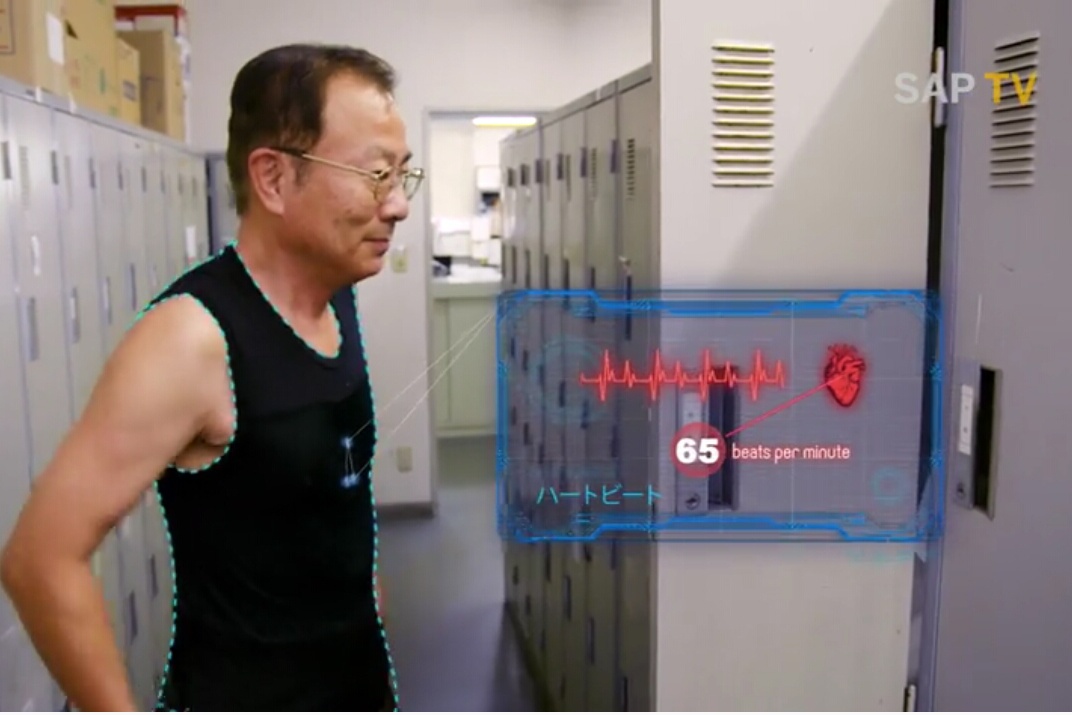Preventing accidents before they can happen, by monitoring a driver’s general health, alertness and stress levels in real time, may sound like something out of a science fiction movie. But these are the times we are living in where what was once fiction, is now a reality. The NTT group, together with SAP, have been working with Japanese bus transport company Keifuku Bus to develop a driver, vehicle and environment monitoring application called Connected Transport Safety (CTS).
“The primary focus of CTS is safety of the passengers. It’s to make bus travel more safe for the passengers. In the past few years, Japan has had some severe bus accidents and this idea was created in a design thinking session with SAP and our team,” said Uwe Bohnhorst, COO of itelligence AG, which is part of NTT Data within the NTT Group. He was speaking at the SAPPHIRE NOW conference held in Orlando this month.
Bohnhorst added that all the bus accidents were due to human failure. “There was no technical failure. We see a huge market opportunity especially in countries like India and China, where there are more accidents,” he elaborated further.
The CTS system consists of the Hitoe shirt worn by bus drivers to monitor and transmit their vitals over the internet – via a mobile phone – to a monitoring station, sensors on the buses to monitor vehicle performance and environmental sensors that report on traffic conditions.
“The Hitoe shirt is all in the fabric. There are transmitters in it that uses a bluetooth connection to a mobile phone, which then transfers the data into the internet. The shirt itself has a lot of innovation processes. We are currently working on making the transmitter smaller and also make it available for wireless charging. Currently there is a small battery in it and it can run out of battery,” he added. The group also has plans to build a SIM card directly into the shirt so that a mobile phone won’t be required as a transmitter.
The shirt monitors the wearer’s drowsiness, fatigue, heart beat, muscle tension – all which are an indication of the stress level of the driver. “It combines the biometrical data from the driver with data from the vehicle and other data sources such as data from the city such as traffic conditions, red lights and traffic jams,” said Bohnhorst.
The data from these three sources – driver, vehicle and the environment – are combined and presented on dashboards built using SAP technology and on the SAP Cloud platform.
NTT has worked with universities and medical institutes to develop algorithms to anticipate stress levels from the data. Once the data is processed, it can alert monitors such as the fleet manager when a driver’s stress level indicators are raised above acceptable thresholds.
When the manager is alerted, he can either choose to call the driver, send him a message or send a replacement driver to meet him somewhere on his route if the driver is felt to be not up to the task. It is up to the fleet manager to decide, said Bohnhorst. He also explained that there were concerns about the effect a call might have on a stressed out driver. A decision on how best to respond to such a situation, might need to be made on a case by case basis.
The CTS system was a joint development effort between NTT Docomo, NTT Com, NTT Group, NTT Data and SAP. NTT Docomo developed the transmitter and the mobile phone interface; NTT Com together with fabric manufacturer Toray developed the Hitoe shirt; the NTT Group developed the infrastructure and communication layer; and NTT Data and SAP worked together on a co-innovation project to develop the application layer.
In a strange turn of events, the Hitoe shirt came first. “NTT Com had this already and they brought it to the discussion and said what can we do from there,” said Bohnhorst.
Bohnhorst felt that NTT was ideally placed to provide solutions such as the CTS that combines infrastructure up to applications all in one group. “NTT has infrastructure, mobile phones, mobile networks. We have connectivity [expertise] with NTT Com and Docomo. With NTT Data we have the expertise in applications and building business cases and expertise to combine SAP technology. We can provide everything from the cable to the keyboard,” he said.
On the subject of the partnership with SAP he said, “The SAP Cloud Platform has a lot of built in technology like predictive analytics and tools to build the dashboards. We were looking for something that gave us enough speed on the backend to process data, enough flexibility to combine it with the other APIs and build business cases and applications around it. We saw SAP as the most relevant and flexible solution there for us.”
NTT only started building the CTS solution last year. “It is quite fast but this is a key element in developing an IoT solution. Ideas are created so quickly and technology is changing so quickly, demands are changing. You need to be agile and flexible,” he concluded.
The company has been running a proof of concept (POC) with Keifuku Bus for 6 to 8 weeks. “The feedback we captured from this company will also be embedded into the product. That’s the nature of all these digitisation [with] IoT devices. You develop something and you prove it against the requirements of the market. Then there is a next innovation cycle on it. Development and innovation is so fast, that you are in a state of constant change,” said Bohnhorst.
When asked how the company measured the success of this project, Bohnhorst admitted that it was difficult to set KPIs on this kind of project. “There were no accidents during the POC period,” he stated and admitted that success for the user may need to be measured in other ways such as its value as a marketing tool and as a means of reducing the insurance premiums for the transport company.
“It can be used as a marketing tool as the company can say we are using this technology and so justify a price premium. They can say they can prevent accidents as the drivers are monitored remotely thereby making it safer to travel with them,” he added.
For NTT a measure of success of this technology is the interest shown by other companies. “There are a lot companies that want to talk to us and understand the opportunities that are on offer,” said Bohnhorst. Interest has been shown from the mining sector, other bus transport companies in the US and the airline industry. NTT is also in talks with SAP on their smart cities initiative and integrating this technology as a part of the municipal transportation functionality in smart cities.
One of the stumbling blocks NTT faced in taking this technology further, is with the issue of data privacy. “The problem we have is that the Hitoe shirt is capturing a lot of vital data from the driver and we have [encountered] some data privacy concerns in Europe and in North America,” stated Bohnhurst. “In Japan it was not a problem getting drivers to wear the shirt. In the US, they have some concern about the data that is captured…that it might be used for other purposes…so there are mixed feelings,” he added.
The next stage for CTS is to run more proof of concepts and develop further uses for it. “We have the technology now – the shirt, the transmission of data, the algorithms and the business case underlying it all. We have a lot of hands on experience with building that solution. If we cut the solution into different components – we can use it for worker safety, we can locate the wearer of the shirt on a map and use it for access control and we can use it to make sure that construction workers are only working in authorised areas,” he added.
Video Source: SAP TV








